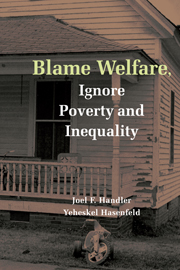Book contents
- Frontmatter
- Contents
- Acknowledgments
- List of Acronyms
- 1 Introduction
- 2 The State of Poverty: TANF Recipients
- 3 The Response to Poverty and Inequality: The Welfare State
- 4 Demonizing the Single-Mother Family: The Path to Welfare Reform
- 5 The Welfare Bureaucracy
- 6 Work and the Low-Wage Labor Market: Mothers and Children
- 7 Welfare Reform and Moral Entrepreneurship: Promoting Marriage and Responsible Parenthood and Preventing Teenage Pregnancy
- 8 Addressing Poverty and Inequality
- References
- Author Index
- Subject Index
4 - Demonizing the Single-Mother Family: The Path to Welfare Reform
Published online by Cambridge University Press: 20 August 2009
- Frontmatter
- Contents
- Acknowledgments
- List of Acronyms
- 1 Introduction
- 2 The State of Poverty: TANF Recipients
- 3 The Response to Poverty and Inequality: The Welfare State
- 4 Demonizing the Single-Mother Family: The Path to Welfare Reform
- 5 The Welfare Bureaucracy
- 6 Work and the Low-Wage Labor Market: Mothers and Children
- 7 Welfare Reform and Moral Entrepreneurship: Promoting Marriage and Responsible Parenthood and Preventing Teenage Pregnancy
- 8 Addressing Poverty and Inequality
- References
- Author Index
- Subject Index
Summary
Single-mother families are in a unique position. General assistance (GA) – the cash aid programs for single adults and childless couples – is much more miserly than TANF (formerly AFDC): the benefits are much lower, the work requirements more onerous, the time limits shorter, and in some states, it has been abolished. General assistance recipients are sometimes pitied, more often stigmatized, but are of low visibility, more or less out of sight. Single-mother families, however, are highly visible – the most visible of all welfare recipients. They are the most controversial and the most stigmatized. The United States is unique among the industrialized countries in how it treats this group of the poor. The reason for this hated position is the explosive combination of racial discrimination and children.
The origins of Aid to Dependent Children (ADC) started in the latter nineteenth century. In the Colonial period, poor mothers were more likely to receive aid than poor men – except poor mothers who were African American or Indian. Throughout most of the nineteenth century, Catholics, the Irish, Jews, and immigrants from southern Europe were objects of prejudice and discrimination. They suffered all the ills of poverty and neglect in the large urban slums. There was little or no public support for these groups, however needy. Most African Americans were still in the rural South. Then, by the mid-twentieth century, after the great migrations to the North, prejudice was directed primarily at African Americans.
- Type
- Chapter
- Information
- Blame Welfare, Ignore Poverty and Inequality , pp. 150 - 185Publisher: Cambridge University PressPrint publication year: 2006

